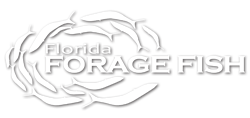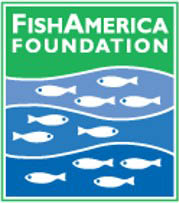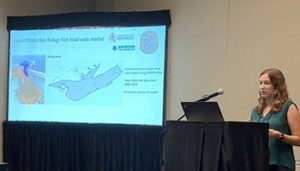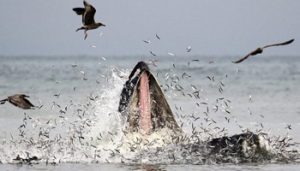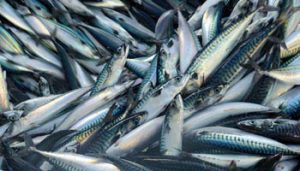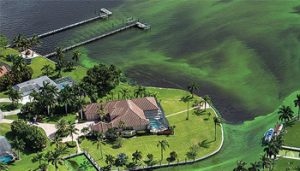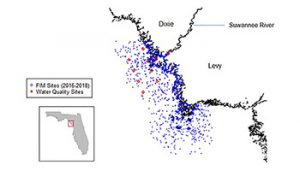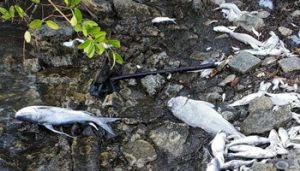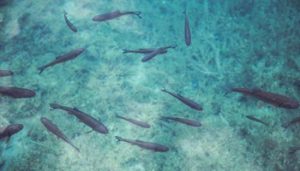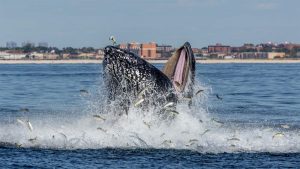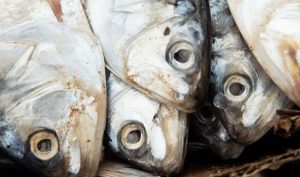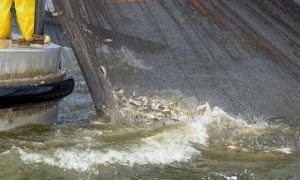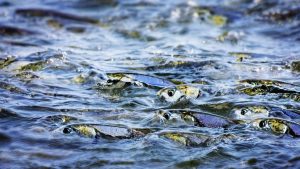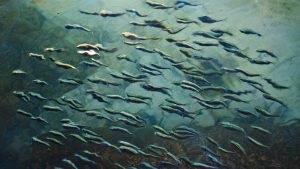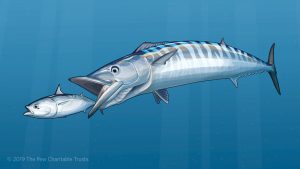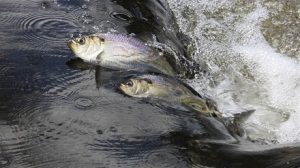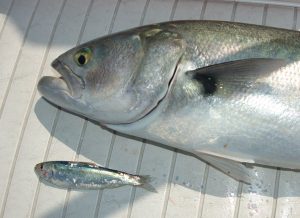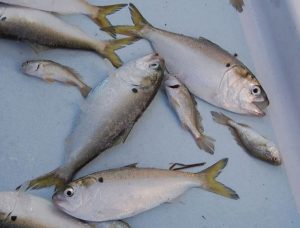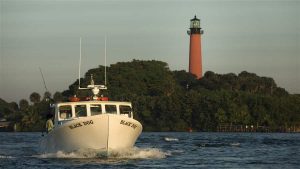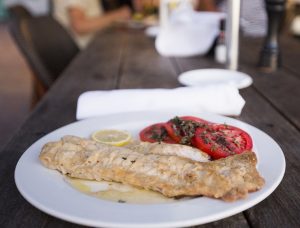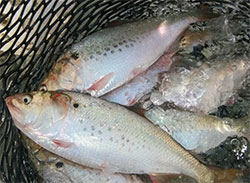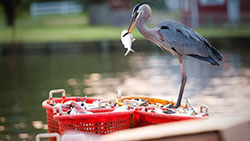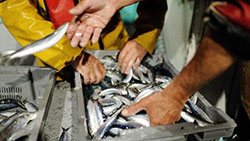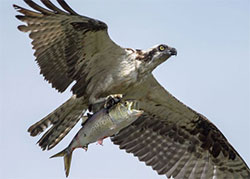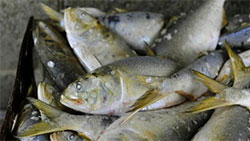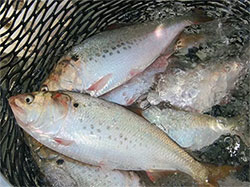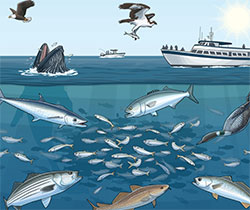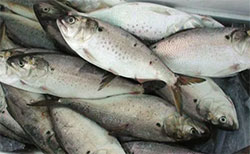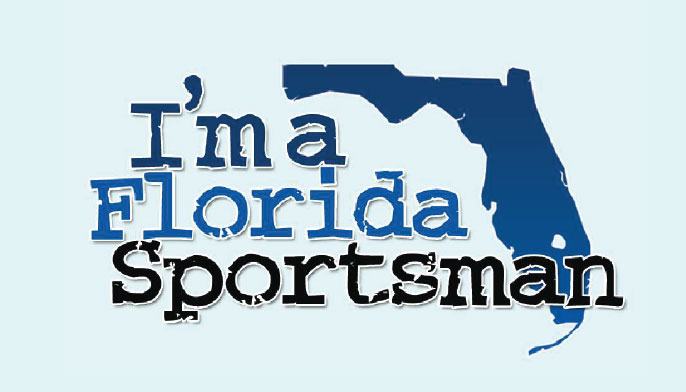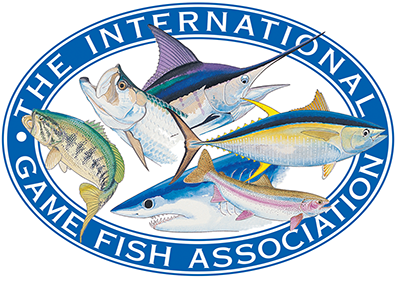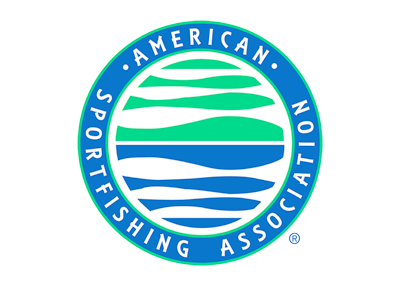The FishAmerica Foundation is the American Sportfishing Association’s conservation and research foundation. We unite the sportfishing industry with conservation groups, government natural resource agencies, corporations and foundations to invest in sportfish and habitat conservation and research across the country.
FISH FLORIDA, a 501(c)(3) non-profit organization, supports organizations that teach people, especially children, about Florida’s fish and aquatic habitats through donations of fishing equipment, grants, and scholarships.
The mission of Fish Florida is to promote public awareness of and encourage the protection of marine fisheries and coastal habitats. This is accomplished through clinics, classes, seminars, presentations, displays and other means designed to teach and promote responsible angling, particularly to Florida’s youth.
When you buy a Grady-White boat you aren’t just purchasing the most exceptional boat on the market, you’re becoming part of the family of Grady owners! We’re a welcoming group who together enjoy a variety of activities from fishing tournaments, seminars and customer appreciation parties to raft ups, and overnight or day trips. First time boat owners will enjoy traveling with seasoned Grady owners where you’ll discover all the best places to enjoy your favorite boating activity. The best part is the camaraderie you’ll derive from Grady ownership. So, climb aboard The Grady Life and experience the best boating lifestyle.
the
news
Trimmel Gomes, Producer
Preliminary research shows less fresh water and higher sea levels could be changing the forage fish in Florida’s famed Apalachicola Bay and the fisheries that depend on them.
Jos Hill & Gillian Lyons, The Pew Charitable Trusts
Northern anchovy are finally catching a break. A key part of the Pacific Ocean food web, these small, nutrient-rich fish are the most important prey for more than 50 species of marine wildlife, from albacore tuna and chinook salmon to least terns and humpback whales.
Moira Donovan, Hakai Magazine
A beloved fish with a rich history has become hard to find—will it rise again?
Trimmel Gomes, Public News Service
For the most part, if you’re a fish, you’re either prey or predator, but Florida research is finding the symbiotic relationship is at risk after outbreaks of harmful algal blooms.
By Dylan Sinnickson, a PhD student at University of Florida.
Examining the effect of different levels of river discharge in the Suwannee River Estuary on forage fish and their predators.
Dakota M. Lewis, researcher at the University of Central Florida
Research tackles the complex issue of how environmental conditions during algal blooms and resulting fish kill events affect forage and sport fish populations.
By Forage fish Research Program fellows Dakota M. Lewis and Emily Farrell
Florida research is finding the symbiotic relationship is at risk after outbreaks of harmful algal blooms.
Video of Dylan Sinnickson, a PhD student at University of Florida.
Studying the impact of anchovy biomass on snook, redfish, and spotted seatrout populations within the Suwannee estuary system.
By Joseph Gordon & Aaron Kornbluth.
Management of species, including catch limits, will provide for the needs of its predators
By John Page Williams, Chesapeake Bay Magazine.
After a tumultuous few years for menhaden management in Virginia, the state will avoid a moratorium on all menhaden fishing as it finally comes into compliance with the East Coast states’ fishery management plan.
By Louisiana State University.
New research suggests that large-scale environmental factors influence the size of one of the ocean’s most abundant forage species.
By Joseph Gordon and Aaron Kornbluth, The Pew Charitable Trusts.
Commission postpones vote to conserve menhaden as science shows its critical role in ecosystem
By Joseph Gordon and Aaron Kornbluth, The Pew Charitable Trusts.
Groundbreaking science- and ecosystem-based measures could be adopted soon
By Leda Cunningham, The Pew Charitable Trusts
Bullet mackerel and frigate mackerel help sportfishing industry—and ecosystem—thrive
By Holly Binns, The Pew Charitable Trusts.
Governor can sign off on a new aquatic preserve to help safeguard coastal economies—and a way of lif
U.S. Rep. Brian Mast
U.S. Representatives Brian Mast (FL-18) and Debbie Dingell (MI-12) introduced bipartisan legislation to strengthen key protections for fisheries and promote responsible management of forage fish.
By Ken Hinman and Pam Lyons Gromen,of Wild Oceans in SportFishing Magazine
Sport-fishing enthusiasts can influence the federal management plan for Atlantic herring: here’s how.
By Steve Bittenbender
The Atlantic States Marine Fisheries Commission has put the state of Virginia on notice regarding the menhaden fishery in the mid-Atlantic state.
By Holly Binns
Instead of focusing on individual species when setting fishing rules, an updated fishery ecosystem plan from the South Atlantic Fishery Management Council sets the foundation for managers to consider the broader marine ecosystem of which they are a part.
This man ate 700 seafood meals in a year -- what he learned about himself and the ocean
By Leah Baumwell
Fish oil pills are the third-largest-selling supplement in the United States. Check out this article in the health benefits of fish oil and their impact on forage fish populations. #littlefishbigdeal
Atlantic Menhaden Board's Shocking Vote
By David Sneed
Atlantic menhaden fishery to follow “status-quo management” despite public’s request for change.
On Menhaden, Fisheries Body Again Ignores the Big Picture
By Joseph Gordon
Last week was big for menhaden, a forage fish that is prey for many wildlife species and is the focus of the East Coast’s largest fishing operation. On Nov. 13 and 14, the Atlantic States Marine Fisheries Commission’s Menhaden Management Board met in Linthicum, Maryland to set catch limits and other policies for this critical species. The result was a mixed bag that shows some promise for working toward the long-term sustainability of menhaden but falls short of the certainty many fisheries experts and conservationists had sought. In the months leading up to the decision, one thing became perfectly clear: Public support for protecting menhaden’s role in the ecosystem has never been stronger.
Why forage fish species are worth fighting for
By Brian Martens
Anyone who has seen a nature documentary knows a central truth of life in the animal kingdom: Predators depend on prey — and will perish if they cannot successfully hunt for their next meal.
In battle for the bunker, it's science and chance for history
By John Howell
Healthy U.S. marine fisheries rely on management plans approved by government stewards that keep prized fish in the water and people in business. It mostly works for the saltwater stars such as striped bass, bluefish, and snappers but not as well for forage fish like menhaden, according to scientists, conservationists, and a variety of stakeholders.
For conservationist Joseph Gordon, a menhaden experience
By John Howell
Menhaden is a pinch-your-nose kind of fish that even its family, including herring, might like to disown. Practically no one eats menhaden on purpose (unless you are popping omega-3 pills). And, according to legend, Squanto introduced the oily little stinker to hungry Plymouth colonists only as fertilizer for their crops.
A Vision for Menhaden: Supporting Anglers, Wildlife, and Businesses From Florida to Maine
On Nov. 13, the Atlantic States Marine Fisheries Commission will take its most important vote yet on how to manage menhaden, which are fished commercially and also support tourism, recreational fishing, and coastal businesses by serving as a key prey species for many predators. Three people who care about menhaden spoke with The Pew Charitable Trusts about what this forage fish means to them. Their answers were lightly edited for clarity and brevity.
Atlantic Menhaden Fishery Faces Crucial Decision
By Ken Hinman
On Monday, November 13, 2017, the Atlantic States Marine Fisheries Commission will meet for two days in Baltimore and decide whether or not to adopt an ecosystems approach to conserving menhaden beginning next year, or stick with the status quo while they study the issue for a few more years.
Fate of 'Most Important Fish in the Sea' Hangs on Commission Decision
By Peter Baker
In just a few months, fishery managers along the U.S. East Coast will make a major decision that will determine the long-term future of one of the region’s most vital species—and the state of the larger Atlantic Ocean ecosystem it powers. Atlantic menhaden, which some fisheries experts call “the most important fish in the sea,” are at the center of the debate—and the food web. On Nov. 13 and 14, the Atlantic States Marine Fisheries Commission (ASMFC), which coordinates the conservation and management of 27 nearshore fish species from Maine to Florida, will set not only the 2018 catch limit for menhaden but also a course for the future. How the commission views menhaden’s role as prey for wildlife in the broader ecosystem will affect hundreds of millions of these fish.
'Most important fish in the sea' to be discussed Oct. 10
By Ed Killer
Anglers know a pogy when they smell one.
It’s as fishy as fishy comes. For my money, it’s the fishiest fish in the sea.
And according to some, pogies — more properly called Atlantic menhaden — are the “most important fish in the sea.” They’re known by as many as five different names, depending on where you fish. I grew up in Jensen Beach and called them bunker.
I'm a Floridian Sportsman
Interview by Jeff Weakley
Behind the scenes of Florida’s diverse and abundant marine life are ranks of scientists committed to documenting the life histories and inter-relationships of fishes. Much of the vital field work is performed by graduate students who, in many cases, literally plunge into their research.
Atlantic Menhaden: Scientist Sign-on Letter
Greetings.
On behalf of Dr.’s Marc Mangel, Tim Essington, Dee Boersma, Les Kaufman, Bill Sydeman, and myself, we request your help to advance fisheries management of a key forage fish, Atlantic menhaden. Menhaden are a major prey item in the diets of many beloved and economically important predators including striped bass, bluefish, tunas, weakfish, cod, king mackerel, cobia, osprey, and humpback whales. The body that manages menhaden – the Atlantic States Marine Fisheries Commission – is on the verge of an historic action that would transition management from a single-species approach (i.e., one that is solely focused on menhaden stock dynamics and the needs of its fishery) to an ecosystem one that prioritizes its role as prey.
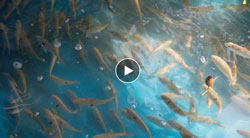
Video: Pinfish released into Indian River Lagoon
Live Advantage Bait at Florida Oceanographic Society is leading a pinfish study in the Indian River Lagoon, where 1,800 pinfish were released Aug. 17, 2017, in Stuart. LEAH VOSS/TCPALM
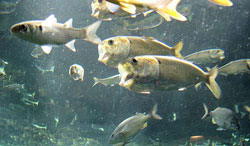
Catch limits - Doing the right thing
by Capt. Gordon Churchill
When resource managers allow fish populations to rebound, anglers get more excited about fishing, the health of our coastal ecosystems improves, and our coastal economies become more robust. A major case in point: The increase of menhaden abundance along North Carolina’s coast.
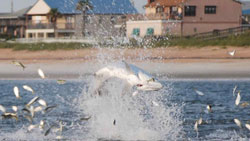
Pogy are knocking, will you heed the call?
by Dominic Agostini
The future of gamefish from striped bass to tarpon are on the line this autumn
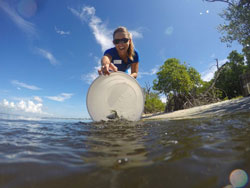
Pinfish released into Indian River Lagoon to help sea grass beds
Brittany Biber, director of animal care at Florida Oceanographic Society, releases a group of tagged pinfish into the Indian River Lagoon on Thursday, Aug. 17, 2017 at Florida Oceanographic Society. The release of 1,800 pinfish is part of a study Live Advantage Bait CEO Nicole Kirchhoff is leading to see if stocking pinfish will help the lagoon's sea grass beds grow.
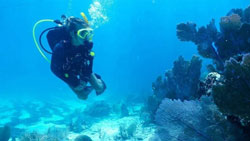
Scientist Discovers Secret Lives of Fish—By Peering Into Their Eyes
by Holly Binns
NEW TECHNIQUE YIELDS DATA ON SPAWNING AND TRAVEL THAT COULD HELP CONSERVE CRITICAL PREY SPECIES
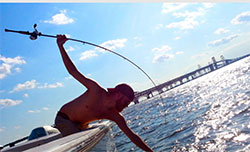
Where Are Forage Fish on the Chesapeake Bay’s Health Report Card?
by Shawn Kimbro
Restoration efforts have helped the Bay earn an above-failing grade, but the tiny fish at the base of the system weren’t even evaluated

The Purpose of Pogies
by Doug Olander
Fish don’t interact. They neither eat other species nor are they eaten by other species. They aren’t affected by polluted waters or loss of habitat or warming ocean temperatures. In fact, the only thing that affects a species of fish is its harvest by fishermen.
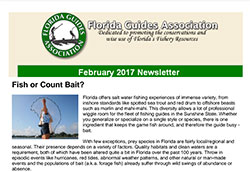
Fish or Count Bait?
Florida offers salt water fishing experiences of immense variety, from inshore standards like spotted sea trout and red drum to offshore beasts such as marlin and mahi-mahi. This diversity allows a lot of professional wiggle room for the fleet of fishing guides in the Sunshine State. Whether you generalize or specialize on a single style or species, there is one ingredient that keeps the game fish around, and therefore the guide busy - bait.
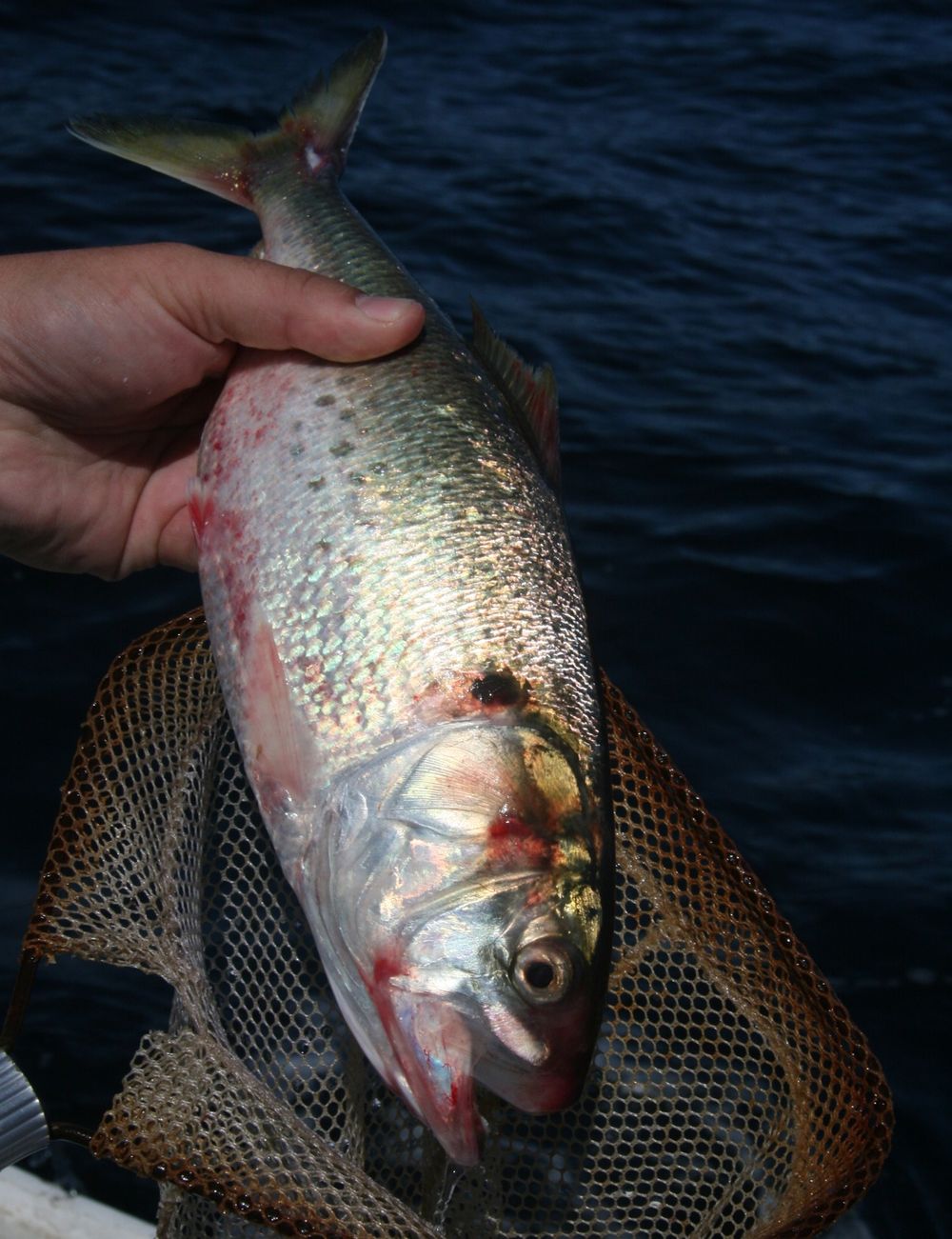
Time to Manage Menhaden Ecologically
by Doug Olander
Fish don’t interact. They don’t eat other species nor are they eaten by other species. They aren’t affected by polluted waters or loss of habitat or warming ocean temperatures. In fact, the only thing that affects a species of fish is its harvest by fishermen.
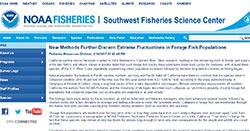
New Methods Further Discern Extreme Fluctuations in Forage Fish Populations
by Fisheries Resources Division
California sardine stocks famously crashed in John Steinbeck’s “Cannery Row.” New research, building on the pioneering work of Soutar and Isaacs in the late 1960’s and others, shows in greater detail that such forage fish stocks have undergone boom-bust cycles for centuries, with at least three species off the U.S. West Coast repeatedly experiencing steep population increases followed by declines long before commercial fishing began.
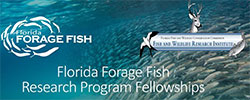
Florida Forage Fish Research Program Fellowships
Too little is known about the small fish that play an outsized role in feeding marine predators from tarpon to sharks.

The Booms and Busts of Forage Fish Populations in California
by Leah Baumwell, IGFA Conservation Coordinator
Pacific sardine (Sardinops sagax), northern anchovy (Engraulis mordax), and Pacific hake (Merluccius productus) (also known as the Pacific Whiting) are the most abundant forage species in the southern California Current System (CCS) and are a resource utilized by larger fish, pinnipeds, sea birds, and cetaceans.

New Methods Further Discern Extreme Fluctuations in Forage Fish Populations
Fisheries Resources Division
California sardine stocks famously crashed in John Steinbeck’s “Cannery Row.” New research, building on the pioneering work of Soutar and Isaacs in the late 1960’s and others, shows in greater detail that such forage fish stocks have undergone boom-bust cycles for centuries, with at least three species off the U.S. West Coast repeatedly experiencing steep population increases followed by declines long before commercial fishing began.
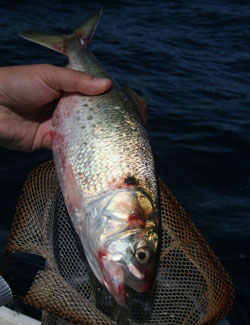
Time to Manage Menhaden Ecologically
Doug Olander
The Atlantic States Marine Fisheries Commission has the chance this year to adopt a plan to safeguard populations of this vital little fish.

Food For Thought.
Rip Cunningham
This column has covered the subject of forage fish in the past. They are not just important to sport-fishing success — they are very important.

1st Annual Forage Fish Data Workshop.
In support of the commitments of FWC’s 2015 Resolution on forage fish conservation, the Florida Forage Fish Coalition recently partnered with the Fish and Wildlife Research Institute (FWRI) to conduct a data analysis workshop with Florida academic institutions.

VIDEO: Huge throng of bait fish spotted off Palm Beach County.
By Alex Hagan
It's not something you see every day. The best way to see a massive bait ball moving through Palm Beach County was from Chopper 5.
You can just call them bait. Read More...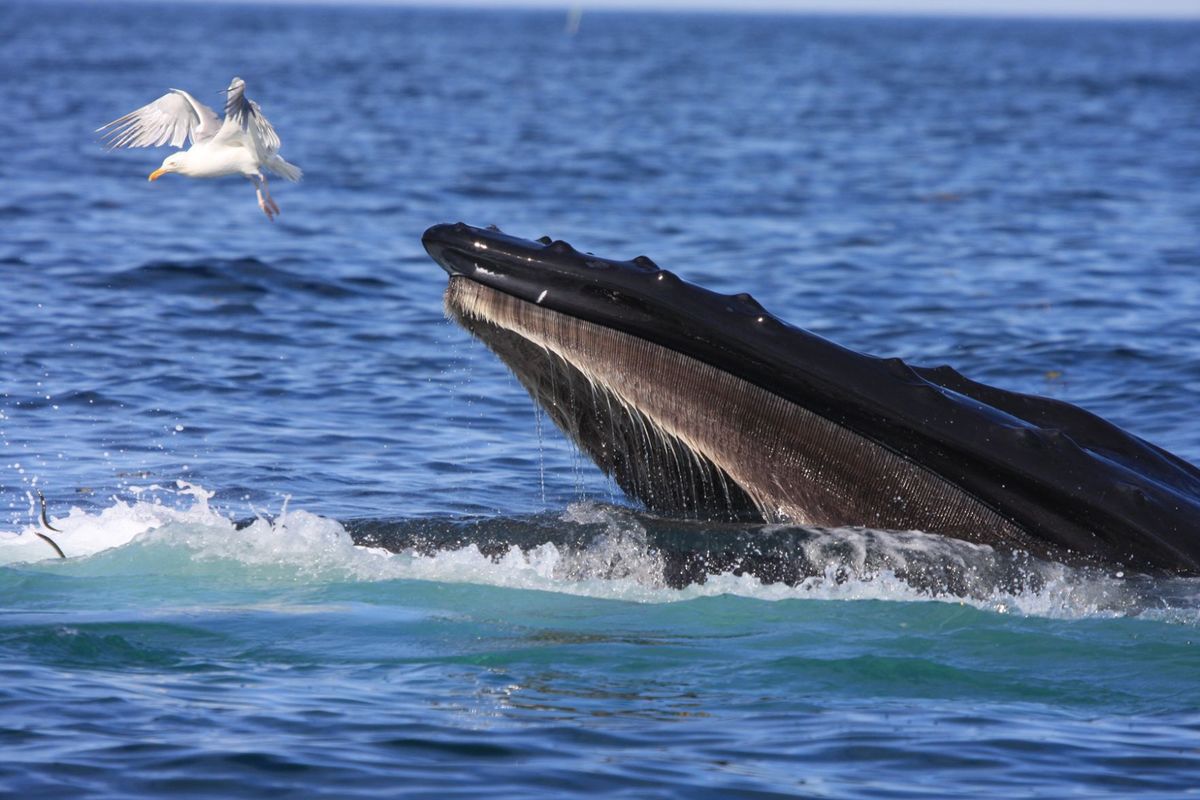
Call them bait. Call them forage species. In any case, now they're protected.
By Dave Mayfield
They’re known by names like greeneyes, pearlsides and halfbeaks, and they’re not marbles nor birds nor precious stones.
They’re fish – more specifically, forage fish, little guys that the big boys like tuna, marlins and whales gorge on out in the ocean.
Read More...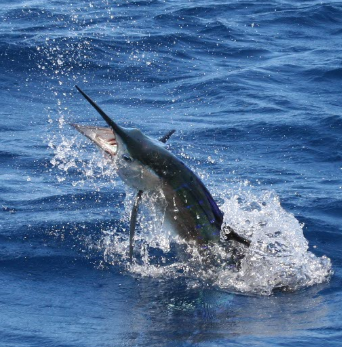
Where are the 'hoos?
By Brett Fitzgerald
If you fish the Atlantic side of the upper Florida Keys, you probably have noticed a disturbing trend that has had huge impacts on the local fishery. Read More...
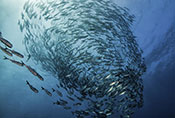
Move to Conserve Baitfish Will Benefit Game Fish, Waterfowl, and Ecosystem
By Terry Gibson
At the United Waterfowlers-Florida’s annual summit last summer, I was reminded why I’ve been a member of this group since its beginnings. To borrow a phrase from the great conservation writer Wendell Barry, "It all turns on affection." Read More...
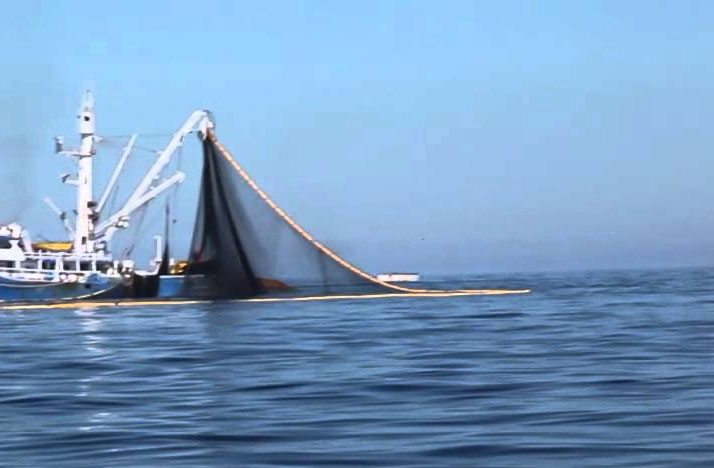
NOAA Proactively Protects Commercial Fishing on Several Species of Forage Fish
NOAA Fisheries published in today’s Federal Register a final rule protecting several species of forage fish of the U.S. West Coast Exclusive Economic Zone (EEZ) by prohibiting directed commercial fishing on the species. Read More...
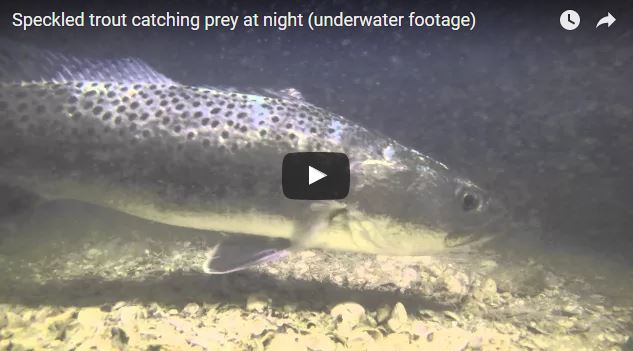
Underwater Footage Shows Speckled Trout Feasting on Prey
By Ben Romans
In January, Florida fisherman Anthony Chacour captured terrific underwater footage of speckled trout feeding on baitfish, and the clip is now making the rounds among anglers. Read More...
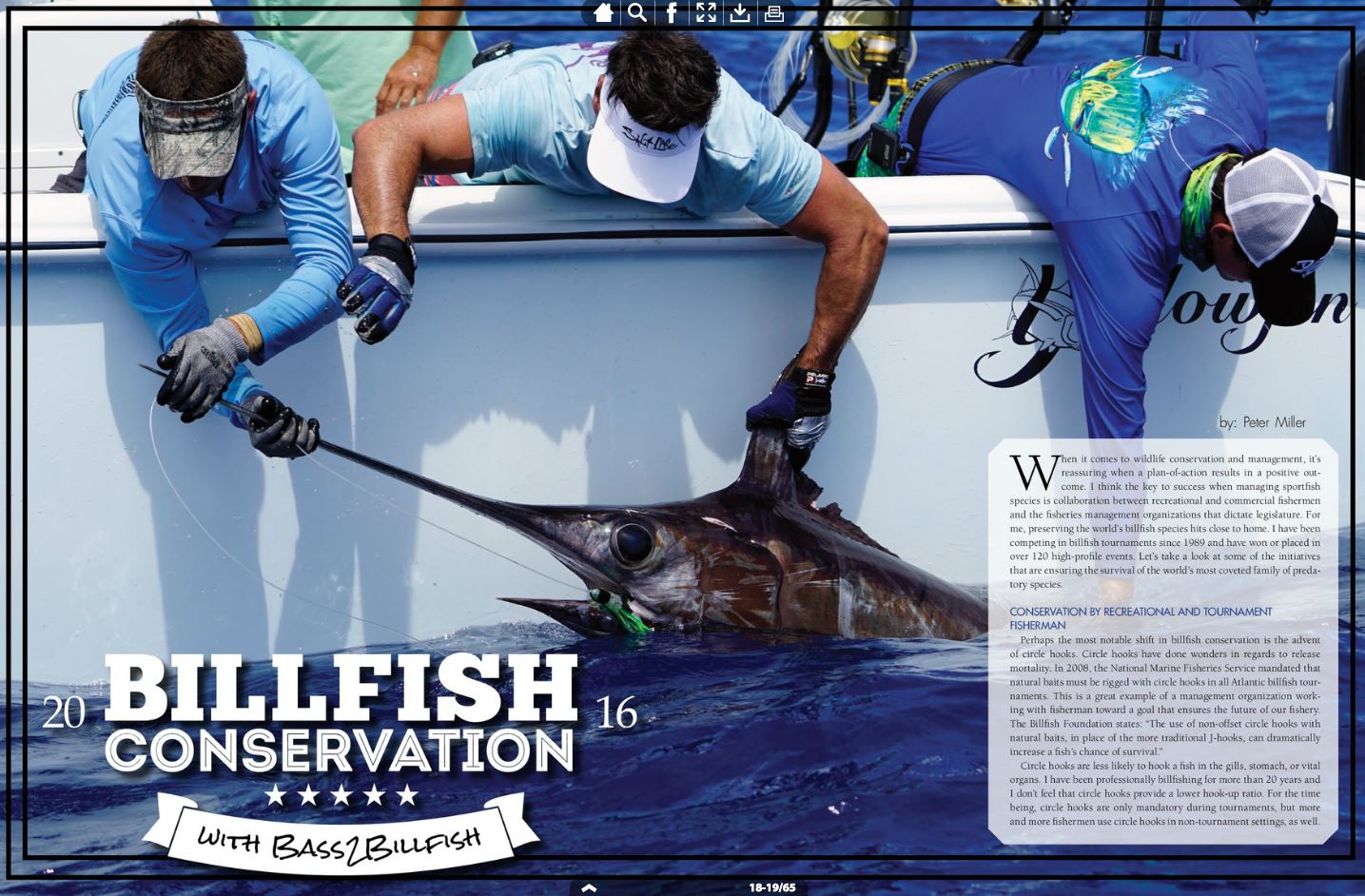
Conservation By Recreational and Tournament Fisherman
By Peter Miller
When it comes to wildlife conservation and management, it's reassuring when a plan of action results in a positive outcome. Read More...
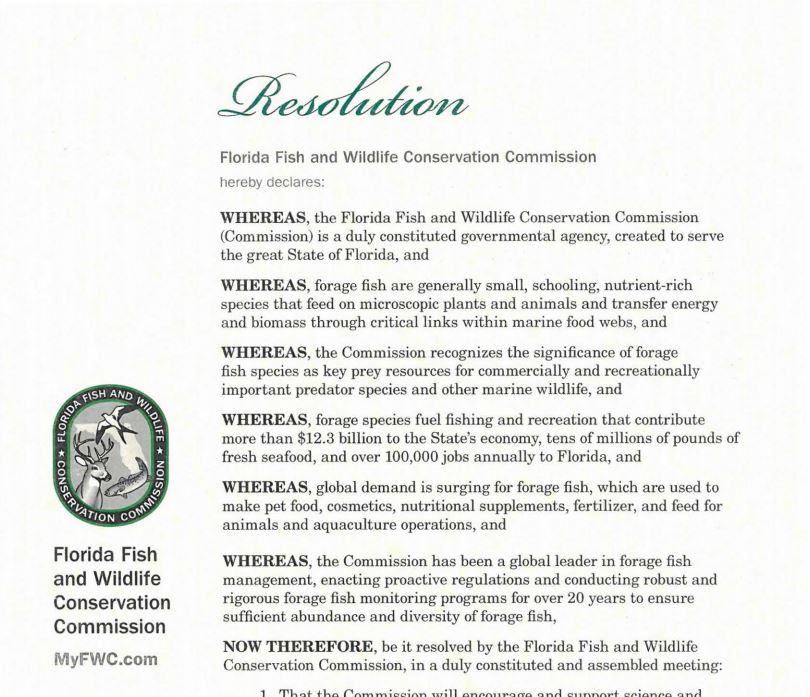
Florida Fish and Wildlife Conservation Commission Adopts Forage Fish Resolutions
At their public meeting on June 25, 2015 the agency adopted a new forage fish resolution, which affirms the state’s commitment to keeping Florida’s forage fish populations healthy and their predators well-fed. Read the resolution here. Read More...

Forage fish processing plant coming to Manatee County
By Michael Pollick
A venture aimed at getting the highest dollar value out of the humble mullet was declared the winner on Monday of the Gulf Coast Community Foundation Innovation Challenge. Read More...
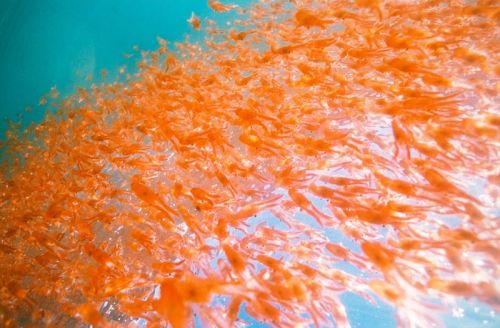
Forage fishes: Extra sardines, and don’t hold the anchovies
By John Howell
Forage fishes are small, schooling fishes that live short, mostly inconspicuous lives. People put anchovies and sardines on pizza not license plates. No one brags about swimming with the scad. There are no T-shirts to save the herring, menhaden, goggle eyes, ballyhoo, or pinfish — are there? Read More...
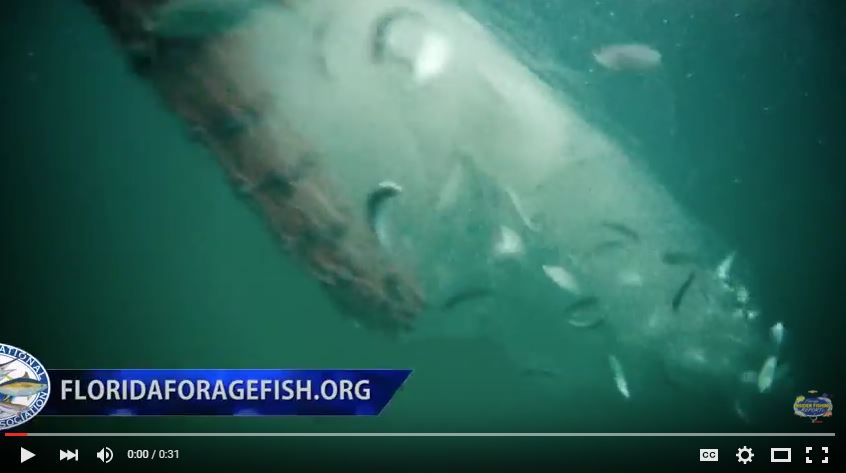
Chevy’s Florida Insider Fishing Report Talks Forage Fish
By John Howell
Forage fishes are small, schooling fishes that live short, mostly inconspicuous lives. People put anchovies and sardines on pizza not license plates. No one brags about swimming with the scad. There are no T-shirts to save the herring, menhaden, goggle eyes, ballyhoo, or pinfish — are there? Read More...
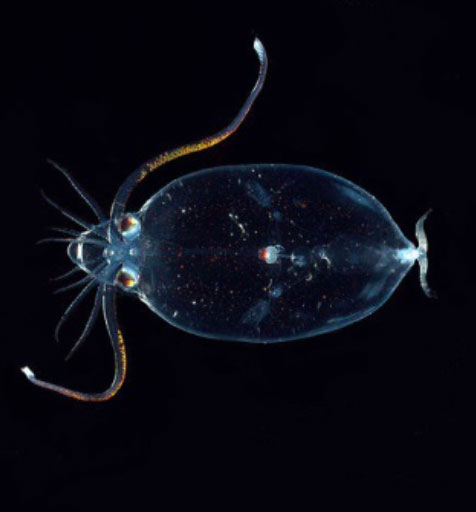
Oregon moves to protect unmanaged forage fish - Marine Resources Program
In the last few years, there has been increasing recognition of the importance of forage fish and interest in ensuring that the forage base is managed and protected. There is universal agreement that to preserve ocean health, especially in the face of climate change, we must protect those species at the bottom of the food chain. The protection is critical as we develop new natural resource policies. Read More...

FLORIDA - Protecting the bait fish that fuel Florida's multi-million dollar fishing industry
By Leah Bauwell, IGFA Conservation Coordinator
Forage fish are small to medium-sized, schoolig species (eg., anchovies, pinfish, herring, scad, menhanden, and sardines) that play a critical role in marine ecosystems by transferring energy to larger fish, marine mammals, and birds who prey on them. Read More...

Bait at the Crossroads. To manage or not, and how?
By Steve Kantner / photos by Pat Ford and Kantner
Salt water baitfish may be on the decline, with no end in sight. So says a growing number of coastal anglers, who view the shortage as affecting their interests—not the least of them, tourism. Whether the problem is real is up for debate. But if proven correct, it could have far-reaching consequences. Read More...
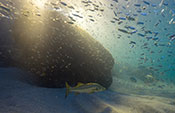
IGFA stresses importance of bait fish management
By Sue Cocking
Forage fish. That’s what scientists call the menhaden, sardines, anchovies, herring and others that larger fish, marine mammals, and seabirds eat. Worldwide, they contribute some $17 billion directly and indirectly as commercial catch. Read More...
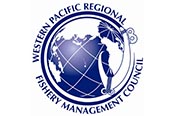
U.S. Pacific Fishery council moves to protect forage fish
By Shelby Sebens
A U.S. government agency that manages West Coast fisheries approved a prohibition on Tuesday on fishing seven categories of forage fish in a groundbreaking decision that signals a shift toward an ecosystem-based management. Read More...
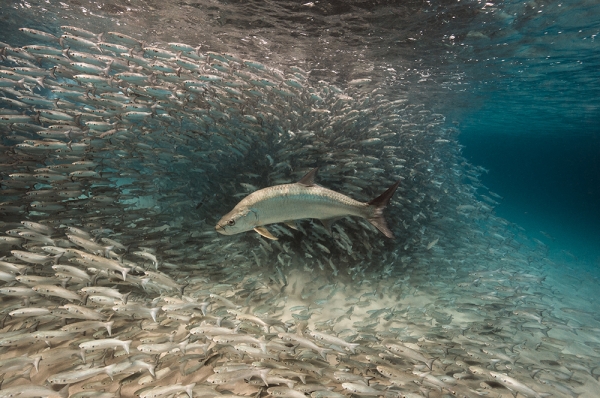
Florida Forage Fish Campaign to Hold the Marine Webs Together
By Christopher Balogh
Like everything in the Animal Kingdom, it's all connected. It can be like playing the game of Jenga, take out one piece and the tower could crumble. Forage fish is one of the bigger pieces in the game. Read More...
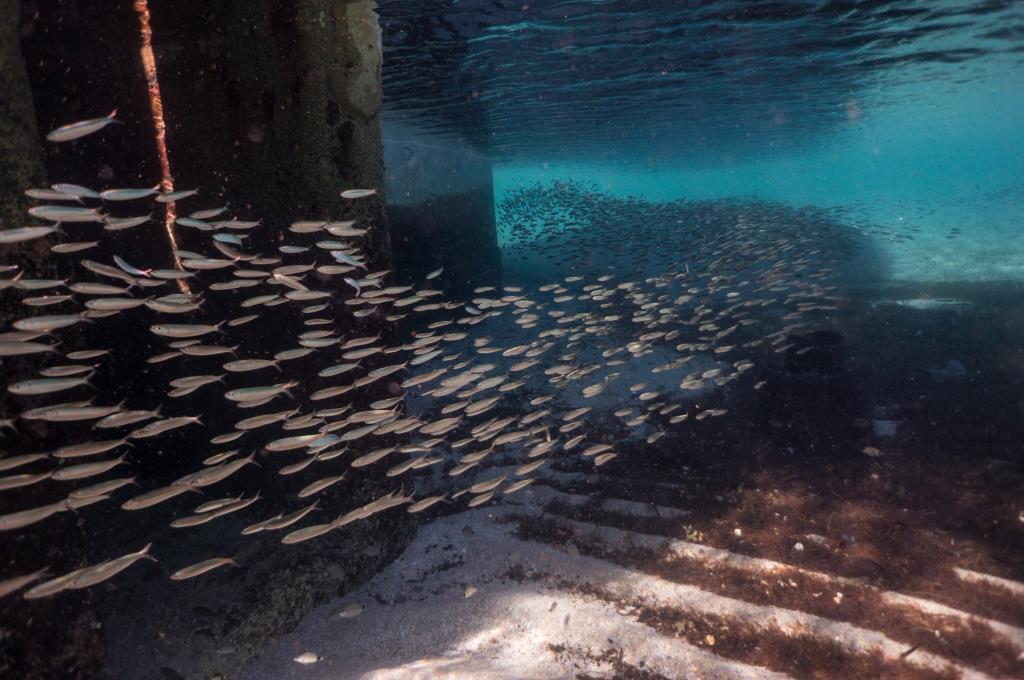
Photographer and free diver Paul Dabill shares photos of underwater food webs
Click here to view stunning underwater slideshow show of ocean food webs or to read the feature on Paul and his views on forage fish habitats.
A Glimpse Into the Underwater Web of Life
The 90-Second Dive That Reveals the Life Just Beneath

Talking With Noted Ocean Forecaster Mitch Roffer
By Terry Gibson
Any good fisherman knows that if you find the bait, you’ll find the fish. This quest has pushed oceanographer Mitchell Roffer, Ph.D., to improve our understanding of what drives fish migrations and how to better forecast when and where anglers can target their favorite species. Read More...

Mid-Atlantic Council Initiates Action to Protect Unmanaged Forage Species
By Terry Gibson
The Mid-Atlantic Fishery Management Council voted at its meeting last week to initiate an action that would protect unmanaged species of forage fish in the Mid-Atlantic. This action would place restrictions on the development or expansion of directed fisheries on these fish. Read More...
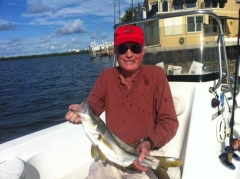
A Father’s Fishing Legacy
By Terry Gibson
During the peak of the 2013 fall mullet run, I took my father fishing on the Indian River Lagoon in eastern Central Florida for the last time. Three months earlier, the 68-year-old sportsman was diagnosed with terminal brain and lung cancer, though he never smoked and led a vigorous physical and intellectual existence. I am happy that he got to fish the mullet run that last time. He died a few days before Thanksgiving. Read More...
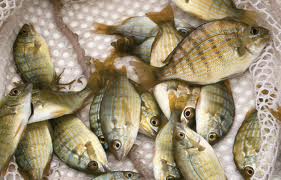
What About the Bait?
By Capt. Danny Barrow
Rock star species? Iconic fish? All of the above? Praise the snook however you will. There’s no denying that the common snook (Centropomus undecimalis) is one of the most important species to attract anglers to the Fishing Capital of the World. Read More...
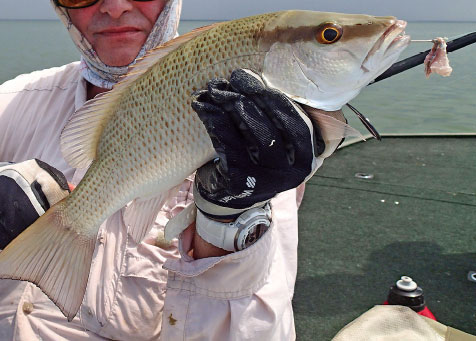
Pinfish Primer: A look at the important life history of a favorite meal for many predators.By Terry Gibson
The summer before the Deepwater Horizon exploded, I went bottom fishing on a headboat out of Panama City, Florida. The boat's enormous livewell was filled with pinfish (Lagodon rhomboides), or "choffers," as they're called locally. These little fish - juveniles, 1 to 2 inches long - had captured the attention of some kids, age about 10 to early teens, aboard the boat. Fun with dip nets made the long run offshore pass quickly. I took advantage of a teachable moment to explain something really quite complex but easily imaginable in that setting. Read More...
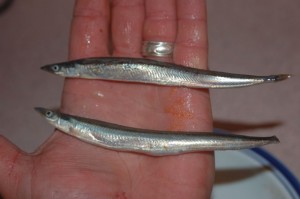
On Forage Fish... Managing the UnmanagedBy Capt. John Murray
Really, if you fish, at all, this is important… for a very basic reason — If there’s no bait, there’s no fishing. If you spend more than a few days on the water every year, you know this to be the case. Read More...

Sardines, Anchovies and Mullet: Small in Size, Big Impact
By Jason Schratwieser
With the exception of live bait aficionados, most recreational anglers habitually focus on large predatory fish rather than small herbivorous ones. Be it salmon or sailfish, our brains naturally focus on fish like these more than they do on species like menhaden or mullet. But should we? Read More...
Our mission is to keep the oceans wild to preserve fishing opportunities for the future. To do this, we bring conservation-minded fishermen and pro-fishing environmentalists together to promote a broad, ecosystems approach to fisheries management that reflects our expanding circle of concern for all marine life and the future of fishing.
FISH FLORIDA, a 501(c)(3) non-profit organization, supports organizations that teach people, especially children, about Florida’s fish and aquatic habitats through donations of fishing equipment, grants, and scholarships.
The mission of Fish Florida is to promote public awareness of and encourage the protection of marine fisheries and coastal habitats. This is accomplished through clinics, classes, seminars, presentations, displays and other means designed to teach and promote responsible angling, particularly to Florida’s youth.
Since 1936, the Florida Wildlife Federation (FWF) has united Floridians throughout the state who are determined to ensure that wildlife and our fragile environment have a voice. FWF believes that we must protect, restore and connect our remaining wildlife habitats in a rapidly developing state. We must address ongoing climate change and the spread of harmful exotic species, both plant and animal, that threaten our native species. Moreover, we must safeguard water quality and quantity as clean water is critically important to both humans and wildlife.
The Angler Action Foundation improves angler access, fisheries science and marine habitat through collaborative Research, Education and Conservation programs.
We support unbiased and responsible fishery and marine regulations and conservation, preservation, restoration, and enhancement of estuarine and coastal water habitats.
For more than 85 years, ASA has passionately represented the people, policies and ideas that help recreational fishing thrive. They give the industry and anglers a unified voice when emerging laws and policies could significantly affect sportfishing business and participation. ASA invests in long-term ventures to ensure the industry remains strong and prosperous, as well as safeguard and promote the enduring economic, conservation and social values of sportfishing in America.
TBEP is an intergovernmental partnership of Hillsborough, Manatee, Pasco and Pinellas counties; the cities of Tampa, St. Petersburg and Clearwater; the U.S. Environmental Protection Agency (EPA); the Southwest Florida Water Management District (SWFWMD); and the Florida Department of Environmental Protection (FDEP).
The FishAmerica Foundation is the American Sportfishing Association’s conservation and research foundation. We unite the sportfishing industry with conservation groups, government natural resource agencies, corporations and foundations to invest in sportfish and habitat conservation and research across the country.
FISH FLORIDA, a 501(c)(3) non-profit organization, supports organizations that teach people, especially children, about Florida’s fish and aquatic habitats through donations of fishing equipment, grants, and scholarships.
The mission of Fish Florida is to promote public awareness of and encourage the protection of marine fisheries and coastal habitats. This is accomplished through clinics, classes, seminars, presentations, displays and other means designed to teach and promote responsible angling, particularly to Florida’s youth.
When you buy a Grady-White boat you aren’t just purchasing the most exceptional boat on the market, you’re becoming part of the family of Grady owners! We’re a welcoming group who together enjoy a variety of activities from fishing tournaments, seminars and customer appreciation parties to raft ups, and overnight or day trips. First time boat owners will enjoy traveling with seasoned Grady owners where you’ll discover all the best places to enjoy your favorite boating activity. The best part is the camaraderie you’ll derive from Grady ownership. So, climb aboard The Grady Life and experience the best boating lifestyle.
